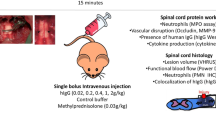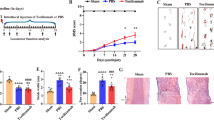Abstract
Tumor necrosis factor (TNF-α) is involved in the inflammation and tissue regeneration occurring after spinal cord injury (SCI). This study tests the specific role of p55 and p75 receptors in mediating the transport of TNF-α across the blood-spinal cord barrier (BSCB) after SCI by compression. Transcytosis of 125I-TNF-α across a monolayer of the cerebral endothelial cells that compose the blood-brain barrier was significantly reduced in the absence of functional p55 and p75 receptors. At 3 d after SCI, double receptor knockout mice had a significantly reduced increase in TNF-α uptake from blood to injured lumbar spinal cord as compared with their inbred controls, despite the similar extent of BSCB disruption (measured by 99mTc-albumin). The p75 single receptor knockout mice had a reduced increase in 125I-TNF-α uptake, whereas the p55 receptor knockout mice had no significant increase of 125I-TNF-α uptake after SCI, suggesting that the p55 receptor plays a major role. Hence, the increased uptake of TNF-α 3 d after SCI is not explained by nonspecific barrier disruption but by receptor-mediated upregulation of transport. Quantitative RT-PCR analysis further showed that upregulation of TNF-α transport was related to increased expression of mRNA for p55 and p75 receptors. The increase of p55 receptor expression was more robust and seen between 12 h and 1 wk after SCI, whereas the increase of p75 receptor expression occurred later and involved fewer regions. Thus, the differential upregulation of p55 and p75 receptors indicates that permeation of TNF-α across the injured BSCB remains a regulated process. Knowledge of receptor-mediated regulation could facilitate effective therapeutic manipulation of BSCB permeation of vascular cytokines important to CNS regeneration.
Similar content being viewed by others
References
Berman J. W., Guida M. P., Warren J., Amat J., and Brosnan C. F. (1996) Localization of monocyte chemoattractant peptide-1 expression in the central nervous system in experimental autoimmune encephalomyelitis and trauma in the rat. J. Immunol. 156, 3017–3023.
Bethea J. R., Nagashima H., Acosta M. C., Briceno C., Gomez F., Marcillo A. E., et al. (1999) Systemically administered interleukin-10 reduces tumor necrosis factor production and significantly improves functional recovery following traumatic spinal cord injury in rats. J. Neurotrauma 16, 851–863.
Bradley J. R., Johnson D. R., and Pober J. S. (1993) Four different classes of inhibitor of receptor-mediated endocytosis decrease tumor necrosis factor-induced gene expression in human endothelial cells. J. Immunol. 150, 5555.
Butowt R. and von Bartheld C. S. (2001) Sorting of internalized neurotrophins into an endocytic transcytosis pathway via the Golgi system: ultrastructural analysis in retinal ganglion cells. J. Neurosci. 21, 8915–8930.
Defazio G., Trojano M., Ribatti D., Nico B., Giorelli M., De Salvia R., et al. (1998) ICAM 1 expression and fluid phase endocytosis of cultured brain microvascular endothelial cells following exposure to interferon beta-1α and TNFα. J. Neuroimmunol. 88, 13–20.
Descamps L., Cecchelli R., and Torpier G. (1997) Effects of tumor necrosis factor on receptor-mediated endocytosis and barrier functions of bovine brain capillary endothelial cell monolayers. J. Neuroimmunol. 74, 173–184.
Dobbie M. S., Hurst R. D., Klein N. J., and Surtees R. A. (1999) Upregulation of intercellular adhesion molecule-1 expression on human endothelial cells by tumour necrosis factor-α in an in vitro model of the blood-brain barrier. Brain Res. 830, 330–336.
Estrada, C., Gomez, C., and Martin, C. (1995) Effects of TNFα on the production of vasoactive substances by cerebral endothelial and smooth muscle cells in culture. Soc. Neurosci. Abstr. 21, 1086.
Fillebeen C., Dehouck B., Benaissa M., Dhennin-Duthille I., Cecchelli R., and Pierce A. (1999) Tumor necrosis factor-alpha increases lactoferrin transcytosis through the blood-brain barrier. J. Neurochem. 73, 2491–2500.
Gutierrez E. G., Banks W. A., and Kastin A. J. (1993) Murine tumor necrosis factor alpha is transported from blood to brain in the mouse. J. Neuroimmunol. 47, 169–176.
Hayashi M., Ueyama T., Nemoto K., Tamaki T., and Senba E. (2000) Sequential mRNA expression for immediate early genes, cytokines, and neurotrophins in spinal cord injury. J. Neurotrauma 17, 203–218.
Hughes J. T. (1992) Disorders of the spine and spinal cord, in Greenfield’s Neuropathology, Adams, J. H. and Duchen, L. W., eds., Oxford University Press, New York, pp. 1083–1089.
Jaeger C. B. and Blight A. R. (1997) Spinal cord compression injury in guinea pigs: structural changes of endothelium and its perivascular cell associations after blood-brain barrier breakdown and repair. Exp. Neurol. 144, 381–399.
Jones S. J., Ledgerwood E. C., Prins J. B., Galbraith J., Johnson D. R., Pober J. S., and Bradley J. R. (1999) TNF recruits TRADD to the plasma membrane but not the trans-Golgi network, the principal subcellular location of TNF-R1. J. Immunol. 162, 1042–1048.
Kim G.-M., Xu J., Xu J., Song S.-K., Yan P., Ku G., et al. (2001) Tumor necrosis factor receptor deletion reduces nuclear factor-κB activation, cellular inhibition of apoptosis protein 2 expression, and functional recovery after traumatic spinal cord injury. J. Neurosci. 21, 6617–6625.
Kim W. K., Kan Y., Ganea D., Hart R. P., Gozes I., and Jonakait G. M. (2000) Vasoactive intestinal peptide and pituitary adenylyl cyclase-activating poly-peptide inhibit tumor necrosis factor-α production in injured spinal cord and in activated microglia via a cAMP-dependent pathway. J. Neurosci. 20, 3622–3630.
Klusman I. and Schwab M. E. (1997) Effects of proinflammatory cytokines in experimental spinal cord injury. Brain Res. 762, 173–184.
Kronke M., Schutze S., Scheurich P., Meichle A., Hensel G., Thoma B., et al. (1990) Tumor necrosis factor signal transduction. Cell. Signal. 2, 1–8.
Lee Y. B., Yune T. Y., Baik S. Y., Shin Y. H., Du S., Rhim H., et al. (2000) Role of tumor necrosis factor-α in neuronal and glial apoptosis after spinal cord injury. Exp. Neurol. 166, 190–195.
Lotan M., Solomon A., Ben-Bassat S., and Schwartz M. (1994) Cytokines modulate the inflammatory response and change permissiveness to neuronal adhesion in injured mammalian central nervous system. Exp. Neurol. 126, 284–290.
Madge L. A. and Pober J. S. (2001) TNF signaling in vascular endothelial cells. Exp. Mol. Pathol. 70, 317–325.
Megyeri P., Abraham C. S., Temesvari P., Kovacs J., Vas T., and Speer C. P. (1992) Recombinant human tumor necrosis factor α constricts pial arterioles and increases blood-brain barrier permeability in newborn piglets. Neurosci. Lett. 148, 137–140.
Nadeau S. and Rivest S. (1999) Effects of circulating tumor necrosis factor on the neuronal activity and expression of the genes encoding the tumor necrosis factor receptors (p55 and p75) in the rat brain: a view from the blood-brain barrier. Neuroscience 93, 1449–1464.
Noble L. J. and Wrathall J. R. (1987) The blood-spinal cord barrier after injury: pattern of vascular events proximal and distal to a transection in the rat. Brain Res. 424, 177–188.
Pan W. and Kastin A. J. (2001a) Increase in TNFα transport after SCI is specific for time, region, and type of lesion. Exp. Neurol. 170, 357–363.
Pan W. and Kastin A. J. (2001b) Upregulation of the transport system for TNFα at the blood-brain barrier. Arch. Physiol. Biochem. 109, 350–353.
Pan W. and Kastin A. J. (2002) TNFα transport across the blood-brain barrier is abolished in receptor knockout mice. Exp. Neurol. 174, 193–200.
Pan W., Banks W. A., and Kastin A. J. (1997a) BBB permeability to ebiratide and TNF in acute spinal cord injury. Exp. Neurol. 146, 367–373.
Pan W., Banks W. A., and Kastin A. J. (1997b) Permeability of the blood-brain and blood-spinal cord barriers to interferons. J. Neuroimmunol. 76, 105–111.
Pan W., Banks W. A., Kennedy M. K., Gutierrez E. G., and Kastin A. J. (1996) Differential permeability of the BBB in acute EAE: enhanced transport of TNF-α. Am. J. Physiol. 271, E636-E642.
Pan W., Kastin A. J., Bell R. L., and Olson R. D. (1999) Upregulation of tumor necrosis factor α transport across the blood-brain barrier after acute compressive spinal cord injury. J. Neurosci. 19, 3649–3655.
Pan W., Zadina J. E., Harlan R. E., Weber J. T., Banks W. A., and Kastin A. J. (1997c) Tumor necrosis factor α: a neuromodulator in the CNS. Neurosci. Biobehav. Rev. 21, 603–613.
Pober J. S. (1988) Cytokine-mediated activation of vascular endothelium, physiology and pathology. Am. J. Pathol. 133, 426–433.
Popovich P. G., Horner P. J., Mullin B. B., and Stokes B. T. (1996) A quantitative spatial analysis of the blood-spinal cord barrier. I. Permeability changes after experimental spinal contusion injury. Exp. Neurol. 142, 258–275.
Saija A., Princi P., Lanza M., Scalese M., Aramnejad E., and De Sarro A. (1995) Systemic cytokine administration can affect blood-brain barrier permeability in the rat. Life Sci. 56, 775–784.
Scherbel U., Raghupathi R., Nakamura M., Saatman K. E., Trojanowski J. Q., Neugebauer E., et al. (1999) Differential acute and chronic responses of tumor necrosis factor-deficient mice to experimental brain injury. Proc. Natl. Acad. Sci. U. S. A. 96, 8721–8726.
Schwartz M., Solomon A., Lavie V., Ben-Bassat S., Belkin M., and Cohen A. (1991) Tumor necrosis factor facilitates regeneration of injured central nervous system axons. Brain Res. 545, 334–338.
Stolphen A. H., Guinan E. C., Fiers W., and Pober J. S. (1986) Recombinant tumor necrosis factor and immune interferon act singly and in combination to reorganize human vascular endothelial cell monolayers. Am. J. Pathol. 123, 16–24.
Tanno H., Nockels R. P., Pitts L. H., and Noble L. J. (1992) Breakdown of the blood-brain barrier after fluid percussive brain injury in the rat. Part 1: Distribution and time course of protein extravasation. J. Neurotrauma 9, 21–32.
Tao-Cheng J.-H., Nagy Z., and Brightman M. W. (1987) Tight junctions of brain endothelium in vitro are enhanced by astroglia. J. Neurosci. 7, 3293–3299.
Tartaglia L. A., Pennica D., and Goeddel D. V. (1993) Ligand passing: the 75-kDa tumor necrosis factor (TNF) receptor recruits TNF for signaling by the 55-kDa TNF receptor. J. Biol. Chem. 268, 18542–18548.
Xu J., Fan G., Chen S., Wu Y., Xu X. M., and Hsu C. Y. (1998) Methylprednisolone inhibition of TNF-alpha expression and NF-κB activation after spinal cord injury in rats. Brain Res. Mol. Brain Res. 59, 135–142.
Yan P., Li Q., Kim G. M., Xu J., Hsu C. Y., and Xu X. M. (2001) Cellular localization of tumor necrosis factor-alpha following acute spinal cord injury in adult rats. J. Neurotrauma 18, 563–568.
Author information
Authors and Affiliations
Corresponding author
Rights and permissions
About this article
Cite this article
Pan, W., Csernus, B. & Kastin, A.J. Upregulation of p55 and p75 receptors mediating TNF-α transport across the injured blood-spinal cord barrier. J Mol Neurosci 21, 173–184 (2003). https://doi.org/10.1385/JMN:21:2:173
Received:
Accepted:
Issue Date:
DOI: https://doi.org/10.1385/JMN:21:2:173




